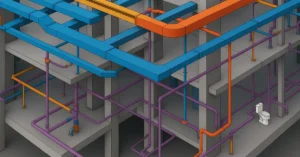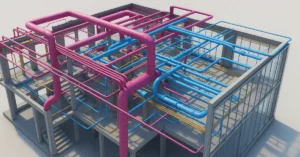The construction industry is on the verge of a major transformation, thanks to the rapid advances in digital technology. In recent years, Building Information Modeling (BIM) and Artificial Intelligence (AI) have emerged as two of the most disruptive technologies that are changing the way buildings are designed, constructed, and managed. In this blog post, we will explore the impact of BIM and AI on the construction industry, and discuss how they can improve productivity, efficiency, sustainability, and safety.

Building Information Modeling (BIM)
BIM is a process that involves creating a 3D digital model of a building and its components. This model can be used by architects, engineers, contractors, and building owners to visualize the building design, simulate its performance, and manage its construction and operation. BIM provides a common language and platform for collaboration among stakeholders, which can reduce errors, conflicts, and delays.
One of the main benefits of BIM is its ability to improve productivity and efficiency. BIM enables designers and engineers to work in a more coordinated and integrated manner, which can reduce rework, waste, and cost. BIM can also automate many repetitive and manual tasks, such as quantity takeoff, scheduling, and clash detection, which can save time and improve accuracy. BIM can also enhance sustainability by providing tools for energy analysis, daylighting, and material selection, which can help reduce the environmental impact of buildings.
Moreover, BIM can enable the creation of smart buildings, which can monitor and control their own systems and interact with their occupants. Smart buildings can improve comfort, health, and safety, while reducing energy consumption and maintenance costs. BIM can also facilitate the use of prefabrication and modular construction, which can enhance quality, speed, and safety.
Artificial Intelligence (AI)
AI is a set of algorithms and machine learning techniques that can enable machines to learn, reason, and adapt to new situations. AI can be used in various applications in the construction industry, such as image recognition, natural language processing, predictive maintenance, and safety monitoring. AI can analyze vast amounts of data and provide insights and recommendations that can improve decision-making and performance.
One of the main benefits of AI is its ability to automate repetitive and dangerous tasks, such as site inspections, equipment monitoring, and quality control. AI can also enhance safety by identifying potential hazards and predicting accidents before they occur. AI can also optimize resource allocation, such as labor, equipment, and materials, which can reduce waste and cost. AI can also improve design and performance by generating alternative solutions and predicting their outcomes.
AI can also enable the creation of digital twins, which are virtual replicas of physical assets. Digital twins can be used to simulate and predict the behavior and performance of buildings and infrastructure, and to optimize their operation and maintenance. Digital twins can also enable real-time monitoring and control of building systems and processes, which can enhance efficiency, comfort, and safety.
Challenges and Opportunities
While BIM and AI offer many benefits to the construction industry, they also pose some challenges that need to be addressed. One of the main challenges is the lack of skilled personnel and training, as BIM and AI require new skills and competencies that are not yet widely available. Another challenge is the interoperability and standardization of data and software, as different stakeholders may use different software and file formats that are not compatible with each other. Moreover, the cost of implementing BIM and AI can be high, especially for smaller firms and projects.
However, despite these challenges, BIM and AI offer significant opportunities for the construction industry to improve its performance and competitiveness. By adopting these technologies, construction firms can enhance their productivity, efficiency, and sustainability, and deliver better quality buildings at lower cost and risk. BIM and AI can also enable greater collaboration and integration among stakeholders, and enhance the overall value of the construction process and product.
Conclusion
The future of construction is digital, and BIM and AI are key drivers of this transformation. By leveraging the power of these technologies, the construction industry can overcome many of its traditional challenges and improve its performance and competitiveness. BIM and AI offer many benefits, such as productivity, efficiency, sustainability, safety, and collaboration, and can enable the creation of smart buildings and infrastructure that meet the needs and expectations of the 21st century. However, adopting these technologies requires a strategic vision, a commitment to innovation, and a willingness to invest in people, processes, and technology. The future of construction is here, are you ready to embrace it?
For more SketchUp tutorials you can check out https://www.sketchupguru.com/blog/
You can also check more tutorial videos for sketchup on our YouTube Channel,
https://www.youtube.com/c/SketchupGuru
To know about the Top Online 3D Rendering Courses for 2022 click,










